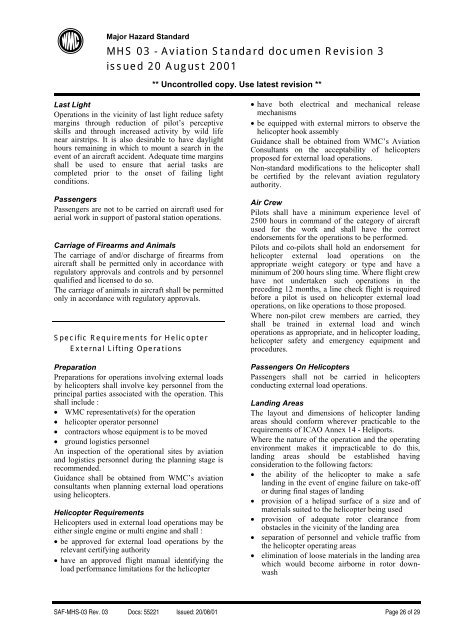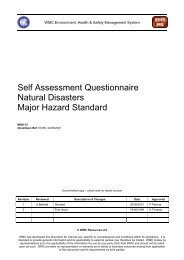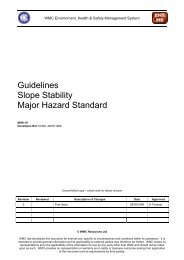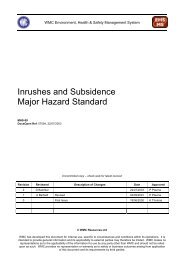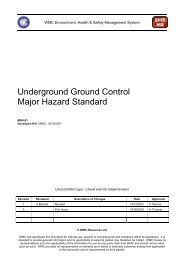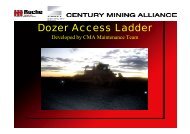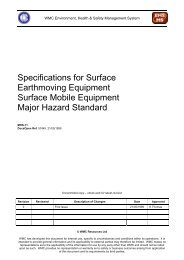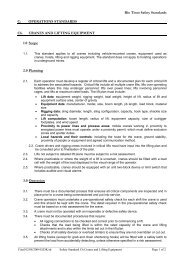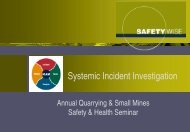Aviation Major Hazard Standard - MIRMgate
Aviation Major Hazard Standard - MIRMgate
Aviation Major Hazard Standard - MIRMgate
You also want an ePaper? Increase the reach of your titles
YUMPU automatically turns print PDFs into web optimized ePapers that Google loves.
<strong>Major</strong> <strong>Hazard</strong> <strong>Standard</strong><br />
MHS 03 - <strong>Aviation</strong> <strong>Standard</strong> documen Revision 3<br />
issued 20 August 2001<br />
** Uncontrolled copy. Use latest revision **<br />
Last Light<br />
Operations in the vicinity of last light reduce safety<br />
margins through reduction of pilot’s perceptive<br />
skills and through increased activity by wild life<br />
near airstrips. It is also desirable to have daylight<br />
hours remaining in which to mount a search in the<br />
event of an aircraft accident. Adequate time margins<br />
shall be used to ensure that aerial tasks are<br />
completed prior to the onset of failing light<br />
conditions.<br />
Passengers<br />
Passengers are not to be carried on aircraft used for<br />
aerial work in support of pastoral station operations.<br />
Carriage of Firearms and Animals<br />
The carriage of and/or discharge of firearms from<br />
aircraft shall be permitted only in accordance with<br />
regulatory approvals and controls and by personnel<br />
qualified and licensed to do so.<br />
The carriage of animals in aircraft shall be permitted<br />
only in accordance with regulatory approvals.<br />
Specific Requirements for Helicopter<br />
External Lifting Operations<br />
Preparation<br />
Preparations for operations involving external loads<br />
by helicopters shall involve key personnel from the<br />
principal parties associated with the operation. This<br />
shall include :<br />
• WMC representative(s) for the operation<br />
• helicopter operator personnel<br />
• contractors whose equipment is to be moved<br />
• ground logistics personnel<br />
An inspection of the operational sites by aviation<br />
and logistics personnel during the planning stage is<br />
recommended.<br />
Guidance shall be obtained from WMC’s aviation<br />
consultants when planning external load operations<br />
using helicopters.<br />
Helicopter Requirements<br />
Helicopters used in external load operations may be<br />
either single engine or multi engine and shall :<br />
• be approved for external load operations by the<br />
relevant certifying authority<br />
• have an approved flight manual identifying the<br />
load performance limitations for the helicopter<br />
• have both electrical and mechanical release<br />
mechanisms<br />
• be equipped with external mirrors to observe the<br />
helicopter hook assembly<br />
Guidance shall be obtained from WMC’s <strong>Aviation</strong><br />
Consultants on the acceptability of helicopters<br />
proposed for external load operations.<br />
Non-standard modifications to the helicopter shall<br />
be certified by the relevant aviation regulatory<br />
authority.<br />
Air Crew<br />
Pilots shall have a minimum experience level of<br />
2500 hours in command of the category of aircraft<br />
used for the work and shall have the correct<br />
endorsements for the operations to be performed.<br />
Pilots and co-pilots shall hold an endorsement for<br />
helicopter external load operations on the<br />
appropriate weight category or type and have a<br />
minimum of 200 hours sling time. Where flight crew<br />
have not undertaken such operations in the<br />
preceding 12 months, a line check flight is required<br />
before a pilot is used on helicopter external load<br />
operations, on like operations to those proposed.<br />
Where non-pilot crew members are carried, they<br />
shall be trained in external load and winch<br />
operations as appropriate, and in helicopter loading,<br />
helicopter safety and emergency equipment and<br />
procedures.<br />
Passengers On Helicopters<br />
Passengers shall not be carried in helicopters<br />
conducting external load operations.<br />
Landing Areas<br />
The layout and dimensions of helicopter landing<br />
areas should conform wherever practicable to the<br />
requirements of ICAO Annex 14 - Heliports.<br />
Where the nature of the operation and the operating<br />
environment makes it impracticable to do this,<br />
landing areas should be established having<br />
consideration to the following factors:<br />
• the ability of the helicopter to make a safe<br />
landing in the event of engine failure on take-off<br />
or during final stages of landing<br />
• provision of a helipad surface of a size and of<br />
materials suited to the helicopter being used<br />
• provision of adequate rotor clearance from<br />
obstacles in the vicinity of the landing area<br />
• separation of personnel and vehicle traffic from<br />
the helicopter operating areas<br />
• elimination of loose materials in the landing area<br />
which would become airborne in rotor downwash<br />
SAF-MHS-03 Rev. 03 Docs: 55221 Issued: 20/08/01 Page 26 of 29


